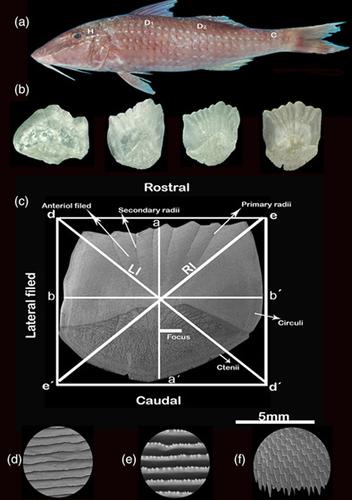当前位置:
X-MOL 学术
›
Microsc. Res. Tech.
›
论文详情
Our official English website, www.x-mol.net, welcomes your
feedback! (Note: you will need to create a separate account there.)
Hidden morphological and structural characteristics in scales of mullid species (Teleostei: Mullidae) using light and scanning electron digital imaging
Microscopy Research and Technique ( IF 2.0 ) Pub Date : 2021-06-13 , DOI: 10.1002/jemt.23837 Sorour Echreshavi 1 , Hamid Reza Esmaeili 1, 2 , Azad Teimori 3 , Mohsen Safaie 4 , Freedon Owfi 5
Microscopy Research and Technique ( IF 2.0 ) Pub Date : 2021-06-13 , DOI: 10.1002/jemt.23837 Sorour Echreshavi 1 , Hamid Reza Esmaeili 1, 2 , Azad Teimori 3 , Mohsen Safaie 4 , Freedon Owfi 5
Affiliation

|
The scale morphology of nine Mullidae taxa consisting of three genera and nine species from the Persian Gulf and the Gulf of Oman was described and compared using light and scanning electron microscopy from four different body regions. The general scale type in the studied mullid species was ctenoid except in the head region of Mulloidichthys vanicolensis and Parupeneus margaritatus, which had cycloid scales. The scales demonstrated a large focus with the central or centro-posterior position. The large variations of scale morphology were observed for the scales from different body regions of a single species. The shape of focus was in five types with the round type being the most common. In the scales of most examined species, there were 5–6 radii present in the anterior field. No radii exist in the lateral and posterior fields, and the radii orientation was parallel in all the studied species. The rostral margin of scales represented five types among the studied species; waved (M. vanicolensis), smooth in (P. rubescens), dentate (Upeneus doriae), scalloped (U. vittatus), and fluted (U. tragula). The lepidont shape varied among the species from blunt to flat, pointed, tiny, sharp, pointed, triangle, short, and long. The results also showed that the relative scale size has a desirable contribution to separate the examined genera. The scale morphological-based tree was largely consistent with the known systematics of the studied fishes. It was concluded that variation of scale characters has probably taxonomic and even phylogenetic information in both species and genus levels in the studied mullid fishes. However, variation of scale morphology between body regions, as shown in this study, suggests that scale characters should be used cautiously for taxonomic studies of these fishes.
中文翻译:

使用光和扫描电子数字成像技术在鱼科动物(Teleostei:Mullidae)鳞片中隐藏的形态和结构特征
使用来自四个不同身体区域的光学和扫描电子显微镜描述和比较了由来自波斯湾和阿曼湾的 3 个属和 9 个物种组成的 9 个 Mullidae 分类群的尺度形态。所研究的鱼种的一般鳞片类型为栉类,但在Mulloidichthys vanicolensis和Parupeneus margaritatus的头部区域除外,具有摆线尺度。鳞片表现出具有中央或中央后部位置的大焦点。观察到来自单一物种不同身体区域的鳞片的鳞片形态变化很大。焦点的形状有五种,以圆形最为常见。在大多数受检物种的尺度中,前场存在 5 到 6 个半径。侧场和后场不存在半径,所有研究物种的半径方向都是平行的。鳞片的喙缘代表了研究物种中的五种类型;波浪形(M. vanicolensis),光滑(P. rubescens),齿状(Upeneus doriae),扇形(U. vittatus)和凹槽(U. tragula ))。蜥蜴的形状因物种而异,从钝的到扁平的、尖的、微小的、尖锐的、尖的、三角形的、短的和长的。结果还表明,相对尺度大小对分离检查的属有理想的贡献。基于尺度形态的树在很大程度上与所研究鱼类的已知系统学一致。得出的结论是,在所研究的细目鱼类中,鳞片性状的变异可能在种和属水平上具有分类学甚至系统发育信息。然而,如本研究所示,身体区域之间鳞片形态的变化表明,在对这些鱼类进行分类学研究时,应谨慎使用鳞片特征。
更新日期:2021-06-13
中文翻译:

使用光和扫描电子数字成像技术在鱼科动物(Teleostei:Mullidae)鳞片中隐藏的形态和结构特征
使用来自四个不同身体区域的光学和扫描电子显微镜描述和比较了由来自波斯湾和阿曼湾的 3 个属和 9 个物种组成的 9 个 Mullidae 分类群的尺度形态。所研究的鱼种的一般鳞片类型为栉类,但在Mulloidichthys vanicolensis和Parupeneus margaritatus的头部区域除外,具有摆线尺度。鳞片表现出具有中央或中央后部位置的大焦点。观察到来自单一物种不同身体区域的鳞片的鳞片形态变化很大。焦点的形状有五种,以圆形最为常见。在大多数受检物种的尺度中,前场存在 5 到 6 个半径。侧场和后场不存在半径,所有研究物种的半径方向都是平行的。鳞片的喙缘代表了研究物种中的五种类型;波浪形(M. vanicolensis),光滑(P. rubescens),齿状(Upeneus doriae),扇形(U. vittatus)和凹槽(U. tragula ))。蜥蜴的形状因物种而异,从钝的到扁平的、尖的、微小的、尖锐的、尖的、三角形的、短的和长的。结果还表明,相对尺度大小对分离检查的属有理想的贡献。基于尺度形态的树在很大程度上与所研究鱼类的已知系统学一致。得出的结论是,在所研究的细目鱼类中,鳞片性状的变异可能在种和属水平上具有分类学甚至系统发育信息。然而,如本研究所示,身体区域之间鳞片形态的变化表明,在对这些鱼类进行分类学研究时,应谨慎使用鳞片特征。









































 京公网安备 11010802027423号
京公网安备 11010802027423号